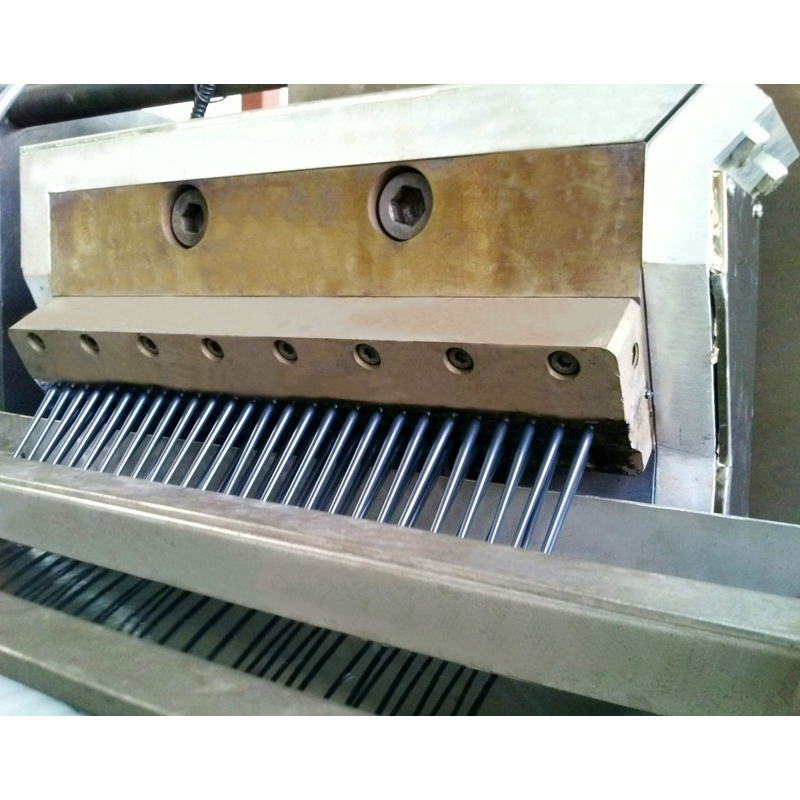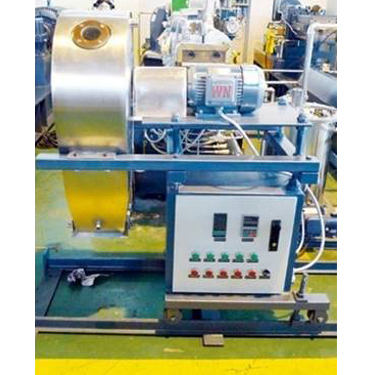Before being made into final pellets, most polymers must be compounding and then pelletized to become marketable products. There are many different pelletizers, but generally, they can be divided into two categories: cooling pelletizing system and hot die face pelletizing system.
The main difference between the two is the time arrangement of the pelletizing process. The cold pelletizing system cuts pellets from the solidified polymer; while in the hot face pelletizing system, pellets are cut when the molten polymer emerges from the die, and the pellets are cooled downstream.

Cooling Pelletizing System
Both pelletizing systems have their advantages and disadvantages. The cooling pelletizer includes a die, a cooling zone (air-cooled or water-cooled), a drying zone (if water-cooled), and a pelletizing chamber. There are two types of cold pelletizing systems, namely flake pelletizers, and strip pelletizers.
The polymer melted by the tablet granulator flows from the mixing equipment through a belt die or roller mill to calender into a certain thickness of polymer flakes. The flakes are solidified and cooled over a distance during transportation, and then cut into round or square pellets with a pelletizer in a bin. Tablet pelletization is the oldest method of manufacturing pellets and can be used for various polymers from nylon to polyvinyl chloride. Cutting the polymer in a solid-state will shorten the life of the cutter, and the generation of powder is often a problem. For some polymers, some "particle chains" can be seen.
The use history of strip pelletizers is almost as long as that of tablet pelletizers. Including die, cooling section (water bath or blower), drying section (if water cooling is used), and pelletizing knife. Use an extruder or gear pump to extrude the molten polymer through a horizontally installed die to form a strip (the modern die is precisely machined and heated uniformly to produce a stable quality strip). After the strip is discharged from the mouth, it is cooled by a blower or air/vacuum facility, or cooled by a water bath. If water cooling is used, the strips need to pass through a drying section, with forced ventilation to blow off the moisture, and then the strips are sent to the cutting room. Using the shearing action of a pair of fixed knives and rotating knives, the strip is accurately cut to the required length. The pellets have a diameter of 3.175 mm and a length of 3.175mm.
The traditional method of drawing strips is to stretch the strips through a cooling section (the most commonly used is a water bath), sometimes causing the strips to fall or have inconsistent dimensions. This is most common in polymers with poor melt strength, such as polypropylene, polyester, and nylon. When the strip falls, the material is scrapped, so operators need to pay close attention. If the strip is drawn inconsistently, the downstream pellets need to be screened.
In other modes, the sliver forming method does not need to be closely monitored by the operator. The method is to use a motor-driven slotted feed conveyor to support and divide the sliver from the die to the pelletizer. The size of the strip conveyed by the rotating force is relatively uniform, will not fall, and therefore has less scrap. Some of these methods can make the production capacity up to 6803.89kg/h, while the stretching method is only about 1814.37kg/h because the operator can only take care of a limited number of strips.
The strip production line has low cost, simple operation, and convenient cleaning. This has its advantages for color compounding because the replacement of two different batches of color materials must thoroughly clean the equipment. However, the disadvantage of the method of making rods is that the cooling section takes up space, and its length is determined by the temperature requirements of the polymer.
Hot Die Face Pelletizing System
There are three basic types of die surface hot cutting systems, namely, airflow granulator, water spray (water ring) granulator, and underwater granulator. Although this type of system can have different designs, a typical system includes a die, a cutting chamber, an electric rotary blade, a cooling medium, and a method of drying pellets (if water cooling is used).

The die is an important part of the die surface thermal granulation system. It is installed vertically or horizontally and is usually heated by oil, steam, or drum or band electric heaters. Electric heating is usually used for smaller dies, and larger dies are usually heated by steam or oil. Die structure materials have different materials, but no matter what material or heating medium is used, the diameter of the die orifice must be uniform. The die must have enough heat to maintain the temperature of the polymer during the entire extrusion process, and the pelletizing knife must be tough and smooth against the rotating die surface. These are necessary to produce uniform pellets.
When the molten polymer is extruded from the die, a pelletizing knife rotating at a high speed cuts it into pellets. The typical situation is that the pelletizing knife is in contact with or very close to the die surface. After the pellets are cut, they are thrown away from the knife by centrifugal force and transported to the cooling medium. The size, shape, material, and installation method of the pelletizing knife can be different. In some systems, the pelletizing knife has a spring applied load to automatically adjust the spacing between the pelletizing knife and the die; while in some systems, the spacing between the pelletizing knife and the die must be manually adjusted. Since the cutter life depends on the accuracy of the knife-die centering, the abrasiveness of the polymer, and the aggressiveness of the operator, it is advisable to cut polymer pellets in the molten state.
The airflow granulator is recommended for polymers that are sensitive to heat and long residence time, such as polyvinyl chloride, TPR, and cross-linked polyethylene. The pelletizing rate is as high as 4989.52kg/h. The flow path of the polymer from the extruder to the pelletizing chamber should be kept as short as possible and the minimum heat should be used. When the polymer is extruded through the die, the rotational force of the rotation of the die surface cuts it into pellets. After the pellets are cut, they are thrown away from the rotating knife and captured by the forced circulation of air in the specially designed pelletizing chamber. The airstream initially quenches the surface of the pellets and takes it out of the pelletizing chamber to the cooling zone.
Fluidized bed dryers are often used to cool pellets. The pellets slide down an adjustable slope, and the circulating fan blows air through the pellets. Adjusting the inclination angle of the inclined plane can extend or shorten the residence time of the pellets in the dryer. Another common cooling method is to discharge the pellets from the cutting chamber into a water tank, and then use a fluidized bed dryer or centrifugal dryer to remove water.
The water jet granulator is suitable for most polymers except those with low melt viscosity or viscosity. This type of equipment is also called a water ring pelletizer, with a pelletizing rate of 13607.77kg/h.
The molten polymer is extruded from the hot die and cut into pellets by a rotating knife rotating on the die surface. The characteristic of this sweet grain system is its specially designed water jet cutting chamber. The water flows spirally around the cause until it flows out of the sweet grain chamber. After the pellets are cut, they are thrown into the water stream for preliminary quenching. The pellet water slurry is discharged into the pellet slurry tank to be further cooled and then sent to a centrifugal dryer to remove water.
The underwater granulator is similar to the airflow granulator and the water spray granulator. The difference is that it has a steady stream of water flowing through the mold surface without direct contact with the mold surface. The size of the pelletizing chamber is preferably just enough to allow the pelletizing knife to rotate freely across the die surface without restricting water flow. The molten polymer is extruded from the die, and the rotating knife cuts the pellets. The pellets are taken out of the pelletizing chamber by the temperature-regulated water and enter the centrifugal dryer. In the dryer, the water is drained back to the storage tank, cooled, and recycled; the pellets are passed through a centrifugal dryer to remove water. The underwater pelletizer needs to use a die with uniform heat distribution and special thermal insulation facilities.
The small pelletizer uses electric heating; the large pelletizer requires an oil-heated or steam-heated die. The process water is heated to the highest temperature under normal circumstances, but its heat should not be enough to cause harmful effects on the free flow of pellets. Underwater pelletizers are used for most polymers, and some models can reach a pelletizing capacity of 22679.62kg/h. When used for cutting low-viscosity or adhesive polymers, the way water flows across the die surface is a big advantage, but for some polymers such as nylon and polyester, this feature may cause the die to freeze. Other advantages are: because the pellets are cut in the molten state, and the water acts as a sound barrier, the noise emission is lower; compared with the cold pelleting system, the number of replacement of pellet cutters is less.




